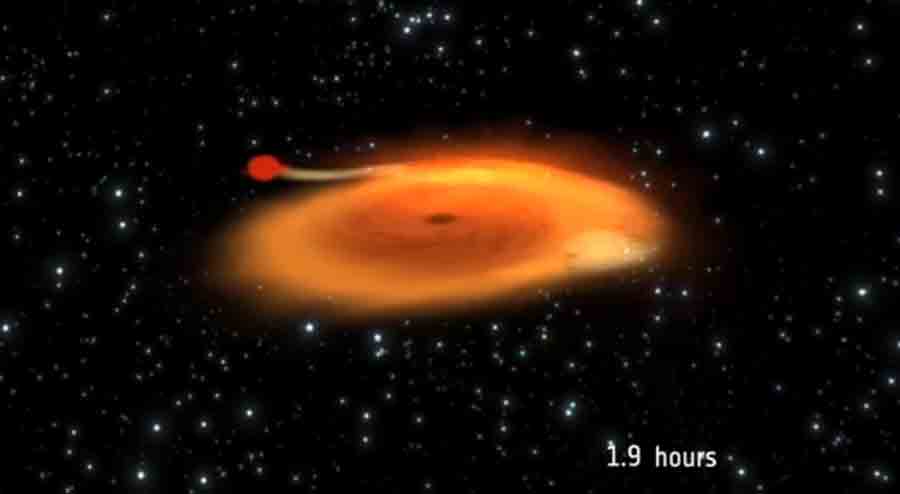The black hole in this compact pairing, known as MAXI J1659-152, is at least three times more massive than the Sun, while its red dwarf companion star has a mass only 20 percent that of our star. The pair is separated by roughly a million kilometers.
NASA’s Swift telescope uncovered the duo September 25, 2010, and scientists initially thought it was a gamma-ray burst. Later that day, Japan’s MAXI telescope on the International Space Station found a bright X-ray source at the same place.
More observations from ground and space telescopes, including XMM-Newton, revealed that the X-rays come from a black hole feeding off material ripped from a tiny companion.
Astronomers saw several regularly spaced dips in the emission in an uninterrupted 14.5-hour observation with XMM-Newton, caused by the uneven rim of the black hole’s accretion disk briefly obscuring the X-rays as the system rotates, its disk almost edge-on along XMM-Newton’s line of sight.
From these dips, they measured an orbital period of just 2.4 hours, setting a new record for black hole X-ray binary systems. The previous record-holder, Swift J1753.5-0127, has a period of 3.2 hours.
The black hole and the star orbit their common center of mass. Because the star is the lighter object, it lies farther from this point and has to travel around its larger orbit at a breakneck speed of 1.2 million mph (2 million km/h). It is the fastest-moving star ever seen in an X-ray binary system. On the other hand, the black hole orbits at “only” 90,000 mph (150,000 km/h).
“The companion star revolves around the common center of mass at a dizzying rate, almost 20 times faster than Earth orbits the Sun,” said Erik Kuulkers of ESA’s European Space Astronomy Center in Spain. “You really wouldn’t like to be on such a merry-go-round in this galactic fair!”
His team also saw that they lie high above the galactic plane, out of the main disk of our spiral galaxy, an unusual characteristic shared only by two other black-hole binary systems, including Swift J1753.5-0127.
“These high galactic latitude locations and short orbital periods are signatures of a potential new class of binary system, objects that may have been kicked out of the galactic plane during the explosive formation of the black hole itself,” said Kuulkers.
Returning to MAXI J1659-152, the quick response of XMM-Newton was key in being able to measure the remarkably short orbital period of the system.
“Observations started at teatime, just five hours after we received the request to begin taking measurements, and continued until breakfast the next day,” said Norbert Schartel from ESA. “Without this rapid response, it would not have been possible to discover the fastest rotation yet known for any binary system with a black hole.”










